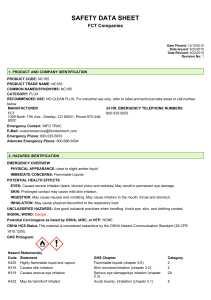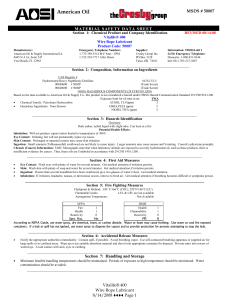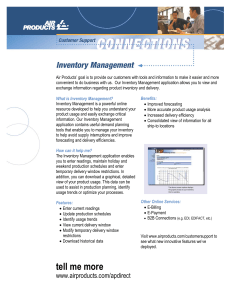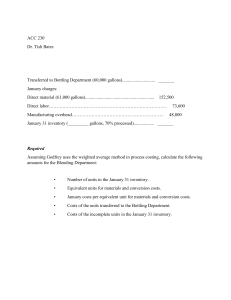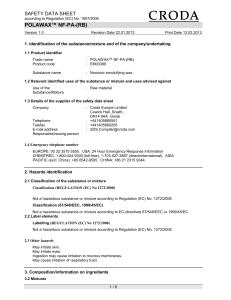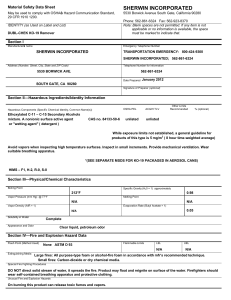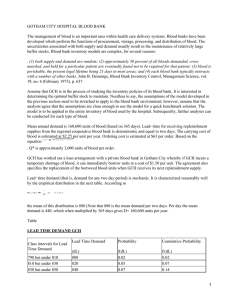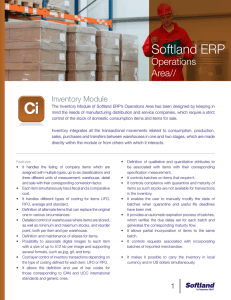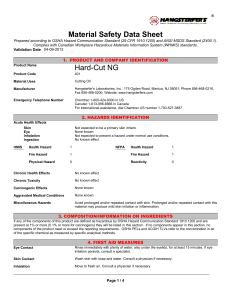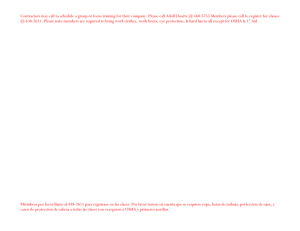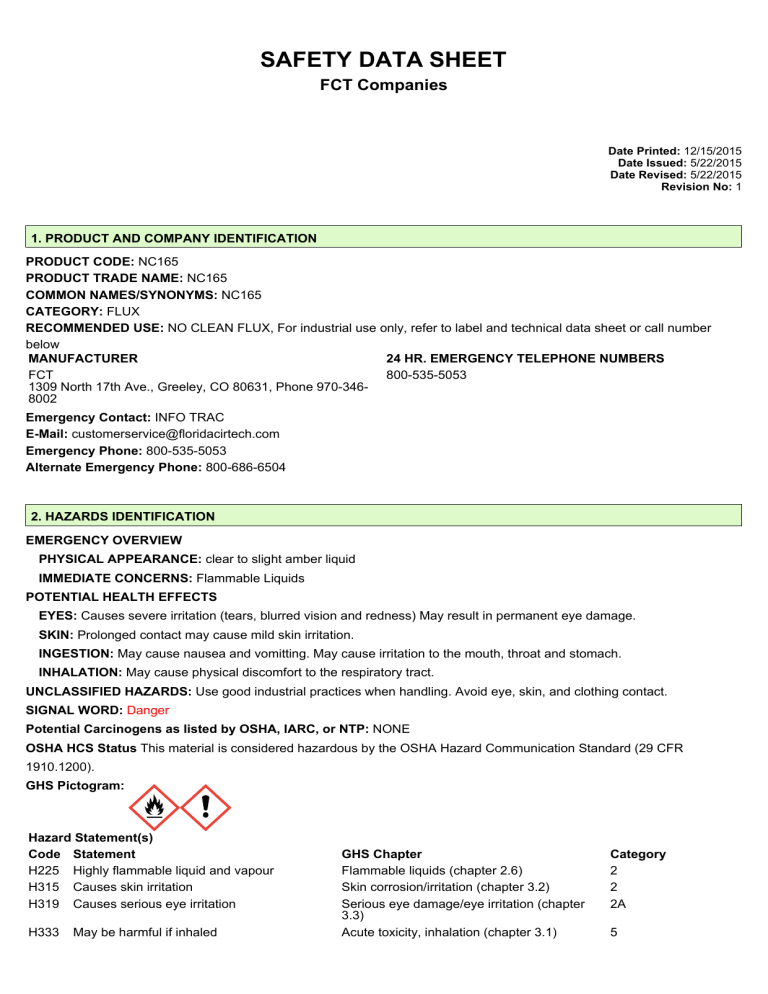
SAFETY DATA SHEET FCT Companies Date Printed: 12/15/2015 Date Issued: 5/22/2015 Date Revised: 5/22/2015 Revision No: 1 1. PRODUCT AND COMPANY IDENTIFICATION PRODUCT CODE: NC165 PRODUCT TRADE NAME: NC165 COMMON NAMES/SYNONYMS: NC165 CATEGORY: FLUX RECOMMENDED USE: NO CLEAN FLUX, For industrial use only, refer to label and technical data sheet or call number below MANUFACTURER 24 HR. EMERGENCY TELEPHONE NUMBERS FCT 800-535-5053 1309 North 17th Ave., Greeley, CO 80631, Phone 970-3468002 Emergency Contact: INFO TRAC E-Mail: [email protected] Emergency Phone: 800-535-5053 Alternate Emergency Phone: 800-686-6504 2. HAZARDS IDENTIFICATION EMERGENCY OVERVIEW PHYSICAL APPEARANCE: clear to slight amber liquid IMMEDIATE CONCERNS: Flammable Liquids POTENTIAL HEALTH EFFECTS EYES: Causes severe irritation (tears, blurred vision and redness) May result in permanent eye damage. SKIN: Prolonged contact may cause mild skin irritation. INGESTION: May cause nausea and vomitting. May cause irritation to the mouth, throat and stomach. INHALATION: May cause physical discomfort to the respiratory tract. UNCLASSIFIED HAZARDS: Use good industrial practices when handling. Avoid eye, skin, and clothing contact. SIGNAL WORD: Danger Potential Carcinogens as listed by OSHA, IARC, or NTP: NONE OSHA HCS Status This material is considered hazardous by the OSHA Hazard Communication Standard (29 CFR 1910.1200). GHS Pictogram: Hazard Statement(s) Code Statement H225 Highly flammable liquid and vapour H315 Causes skin irritation H319 Causes serious eye irritation H333 May be harmful if inhaled GHS Chapter Flammable liquids (chapter 2.6) Skin corrosion/irritation (chapter 3.2) Serious eye damage/eye irritation (chapter 3.3) Acute toxicity, inhalation (chapter 3.1) Category 2 2 2A 5 NC165 Page 2 of 7 H335 May cause respiratory irritation H336 May cause drowsiness or dizziness Precautionary Statement(s) P210 P240 P241 P264 P270 P271 P305+ P351 + P338 P312 P405 P501 Specific target organ toxicity, single exposure; 3 Respiratory tract irritation(chapter 3.8) Specific target organ toxicity, single exposure; 3 Narcotic effects (chapter 3.8) Keep away from heat/sparks/open flames/hot surfaces. - No smoking. Ground/bond container and receiving equipment. Use explosion-proof electrical/ventilating/lighting/.../equipment. Wash skin thoroughly after handling. Do no eat, drink or smoke when using this product. Use only outdoors or in a well-ventilated area. IF IN EYES: Rinse cautiously with water for several minutes. Remove contact lenses, if present and easy to do. Continue rinsing. Call a POISON CENTER or doctor/physician if you feel unwell. Store locked up. Dispose of contents/ container to an approved waste disposal plant. 3. COMPOSITION / INFORMATION ON INGREDIENTS Chemical Name Isopropanol Mixed Aliphatic Alkyl Common Names CAS Isopropanol 67-63-0 Mixed Aliphatic Alkyl 1119-40-0 Weight %age 70.00 % - 90.00 % 10.00 % - 30.00 % 4. FIRST AID MEASURES COMMON SYMPTOMS OF OVEREXPOSURE: No Applicable data available EYES: Immediately flush with water for at least 15 minutes or until the chemical is removed. SKIN: Wash off immediately with soap and water. If clothing is contaminated, remove and launder before reuse. INGESTION: If conscious, rinse mouth with water. Seek medical advice on whether to induce vomiting. Never give anything by mouth to an unconscious person. Get medical attention. INHALATION: Move to fresh air. Get medical attention if symptoms occur. NOTES TO PHYSICIAN: Follow usual and customary procedures ADDITIONAL INFORMATION: No Applicable data available COMMENTS: No Applicable data available 5. FIRE FIGHTING MEASURES FLASH POINT AND METHOD: No applicable data available FLAMMABLE LIMITS: LEL : No applicable data available UEL: No applicable data available GENERAL HAZARD: As with any chemical fire, combustion products of unknown toxicity are always possible. EXTINGUISHING MEDIA: Carbon dioxide, dry chemical, foam or water spray. FIRE FIGHTING EQUIPMENT: Vapors and fumes may be irritating and toxic. Firefighters should wear selfNo applicable data availablecontained breathing apparatus and full fireNo applicable data availablefighting turnout gear. SENSITIVE TO STATIC DISCHARGE: No applicable data available COMMENTS: Standard procedure for chemical fires. 6. ACCIDENTAL RELEASE MEASURES SMALL SPILL: Absorb spilled liquid in a suitable material. Sweep or vacuum material into disposal containers. LARGE SPILL: Absorb spilled liquid in a suitable material. Sweep or vacuum material into disposal containers. NC165 Page 3 of 7 EMERGENCY PROCEDURES: For hazardous waste regulations call 800-424-9346, the RCRA Hotline. Personal precautions, protective equipment and emergency procedures: Evacuate area. Keep upwind of spill. Refer to section 7, Handling, for additional precautionary measures. Only trained and properly protected personnel must be involved in cleanup operations. Ventilate area of leak or spill. Use appropriate safety equipment. For additional information, refer to Section 8, Exposure Controls and personal protection. GENERAL PROCEDURES: If possible, stop further leakage of the material. Contain spilled material by diking with nonflammable diking materials. RELEASE NOTES: Collect as much as possible in a clean container for reuse (if not contaminated) or disposal (if contamintated). Prevent from entering into soil, ditches, sewers, waterways and/or ground water. See section 12 Ecological information. SPECIAL PROTECTIVE EQUIPMENT: Isolate area. Use appropriate safety equipment. For additional information, refer to section 8, Exposure Controls and Personal Protection. COMMENTS: See also section 13 for disposal information. 7. HANDLING AND STORAGE HANDLING: Keep away from heat, sparks and flame.Use grounding when transferring this material to prevent static discharge. Avoid eye, skin, and clothing contact. Do not inhale mist or vapors. Do not taste or swallow. Use only with adequate ventilation. STORAGE: Keep container closed when not in use. Avoid elevated and freezing temperatures. 8. EXPOSURE CONTROLS / PERSONAL PROTECTION Chemical Name Isopropanol Mixed Aliphatic Alkyl OSHA PEL 400 ppm NE OSHA STEL NE NE ACGIH TWA 400 ppm NE ACGIH STEL 500 ppm NE ENGINEERING CONTROLS: Work in well ventilated areas. Do not breathe vapors or mist. Ensure that existing ventilation is sufficient to prevent the circulation and/or accumulation of vapors in the air. PERSONAL PROTECTIVE EQUIPMENT: EYES AND FACE: Eye protection such as chemical splash goggles and/or face shield must be worn when possibility exists for eye contact due to splashing or spraying liquid, airborne particles, or vapor. SKIN: Wear nitrile or latex gloves. Wear protective clothing. RESPIRATORY: Where risk assessment shows air-purifying respirators are appropriate use a full-face respirator with multipurpose combination (US) or type ABEK (EN 14387) respirator cartridges as a backup to engineering controls. If the respirator is the sole means of protection, use a full-face supplied air respirator. Use respirators and components tested and approved under appropriate government standards such as NIOSH (US) or CEN (EU). WORK HYGIENIC PRACTICES: Discard contaminated gloves after use. Have eye-wash facilities in the immediate vicinity. Work in adequately ventilated area. Do not breathe vapors or mist. Minimize any contact with any chemical. COMMENTS: Eye wash station and safety shower should be available in immediate work area. To identify additional Personal Protective Equipment (PPE) requirements, it is recommended that a hazard assessment, in accordance with the OSHA PPE Standard (29 CFR 1910.132), be conducted before using this product. 9. PHYSICAL AND CHEMICAL PROPERTIES Appearance Form: Liquid Appearance Color: Amber Odor: Alcohol Odor Threshold: Not Determined NC165 Page 4 of 7 pH-value @ 68 °F: 3-4 Melting point: Not Determined Boiling Point: 180 F Flash Point: 15 Flammability: no data available Ignition temperature: no data available Auto Igniting: no data available Danger of explosion: no data available Explosion Lower Limit: 2 Explosion Upper Limit: 12 Vapor pressure @ 68 °F: 30 Relative Density: .825 Vapor Density: 2.1 Evaporation Rate: N/A Solubility in Water: Complete Partition coefficient: no data available Dynamic viscosity: no data available Kinematic viscosity: no data available Organic Content %age: no data available Water %age: no data available Solids Content %age: no data available Other Informartion: no data available 10. STABILITY AND REACTIVITY STABILITY: Stable REACTIVITY: See sub-sections below. POLYMERIZATION: Hazardous polymerization is not expected to occur under normal temperatures and pressures. CONDITIONS TO AVOID: Heat, sparks, open flames POSSIBILITY OF HAZARDOUS REACTIONS: None expected. INCOMPATIBLE MATERIALS: Strong Oxidizers HAZARDOUS DECOMPOSITION MATERIALS: Carbon Dioxide, Carbon Monoxide and HCl gas. 11. TOXICOLOGICAL INFORMATION SKIN: Skin Corrosion/Irritation: Mildly irritating., Skin Acute Toxicity: Minimally toxic EYES: Severely irritating. INHALATION: Minimally toxic INGESTION: Minimally toxic CARCINOGENICITY IARC: None of the components of this product are listed as a carcinogen by IARC, NTP, OSHA, or ACGIH. NTP: None of the components of this product are listed as a carcinogen by IARC, NTP, OSHA, or ACGIH. OSHA: None of the components of this product are listed as a carcinogen by IARC, NTP, OSHA, or ACGIH. DERMAL TOXICITY: Minimally toxic MUTAGENICITY: Not Determined SENSITIZATION: Not Determined TERATOGENICITY: Not Determined REPRODUCTIVE EFFECTS: Not Determined NC165 Page 5 of 7 TARGET ORGAN EFFECTS: Not Determined ADDITIONAL INFORMATION: no additional information. 12. ENVIRONMENTAL INFORMATION PRODUCT TEST DURATION same as sds name - No applicable data available ORGANISM TYPE No applicable data available TEST RESULTS No applicable data available ECOTOXICITY: no applicable data available BIOACCUMULATION: Not determined PERSISTENCE DEGRADABILITY: Degradation is expected under aerobic and anaerobic conditions. MOBILITY: Appreciable volitilization is expected from water to air. ENVIRONMENTAL DATA: no applicable data available 13. DISPOSAL CONSIDERATIONS DISPOSAL METHOD: Dispose of in accordance with national, state and local regulations. It is the waste generator's responsibility to determine if a particular waste is hazardous under RCRA. EMPTY CONTAINER: Empty Container Warning (Where applicable). Empty Containers may contain residue and can be dangerous. Do not attempt to refill or clean containers without proper instructions. Empty containers should be taken for recycling, recovery or disposal through suitably qualified or licensed contractor and in accordance with governmental regulations. DISPOSAL INSTRUCTIONS: The generation of waste should be avoided or minimized wherever possible and should at all times comply with the requirements of evironmental protection and waste disposal legislation and any regional local authority requirements. WASTE FROM RESIDUES / UNUSED PRODUCTS: For hazardous waste regulations call 800-424-9346, the RCRA Hotline. CONTAMINATED PACKAGING: For hazardous waste regulations call 800-424-9346, the RCRA Hotline. 14. TRANSPORT INFORMATION DOT (DEPARTMENT OF TRANSPORTATION) PROPER SHIPPING NAME: FLAMMABLE LIQUIDS, n.o.s. (ISOPROPANOL, MIXED ALIPHATIC ALKYL), TECHNICAL NAME: no applicable data available PRIMARY HAZARD CLASS/DIVISION: 3, UN/NA NUMBER: UN1993, PACKING GROUP: PG II NAERG: 128 LABEL: 3, EMS NO: Not Applicable ADDITIONAL INFO: none 15. REGULATORY INFORMATION UNITED STATES TSCA (TOXIC SUBSTANCE CONTROL ACT) TSCA STATUS: On the inventory, or in compliance with the inventory US federal regulations NC165 Page 6 of 7 TSCA Section 12(b) Export Notification (40 CFR 707, Subpt. D) US. OSHA Specifically Regulated Substances (29 CFR 1910.1001-1050) no applicable data available CERCLA Hazardous Substance List (40 CFR 302.4): NO Superfund amendments and reauthorization act of 1986 (SARA) SARA 302 Extremely hazardous substance NO SARA 304 Emergency release notification no applicable data available SARA 311/312 Hazardous chemical no applicable data available SARA 313 (TRI reporting) NO Clean Water Act Section 311 Hazardous Substances (40 CFR 117.3) no applicable data available Clean Air Act (CAA) Section 112(r) Accidental Release Prevention (40 CFR 68.130):no applicable data available US state regulations US. California Proposition 65: NO US. New Jersey Worker and Community Right-to-Know Act: no applicable data available US. Massachusetts RTK - Substance List: no applicable data available US. Pennsylvania RTK - Hazardous Substances: no applicable data available US. Rhode Island RTK: no applicable data available Inventory Status: Europe REACH: On the inventory, or in compliance with the inventory USA TSCA: On the inventory, or in compliance with the inventory Canada DSL: On the inventory, or in compliance with the inventory Australia AICS: On the inventory, or in compliance with the inventory New Zealand NZIOC: On the inventory, or in compliance with the inventory Japan ENCS: On the inventory, or in compliance with the inventory Korea KECI: On the inventory, or in compliance with the inventory Philippines PICCS: On the inventory, or in compliance with the inventory China IECSC: On the inventory, or in compliance with the inventory 16. OTHER INFORMATION TITLE: EHS Management PREPARED BY: FCT EHS and Compliance Dept. HEALTH: 1 FIRE: 3 REACTIVITY: 0 3 1 0 MANUFACTURER SUPPLEMENTAL NOTES: no applicable data available MANUFACTURER DISCLAIMER: The information contained herein is based on data believed to be accurate and is offered at no charge. No warranty is expressed or implied regarding the accuracy of this data. Liability is expressly disclaimed for loss or injury arising out of use of this information or the use of any materials designated. It is the user's responsibility for determining whether the product is suitable for its intended conditions of use. NC165 Page 7 of 7 Key or legend to abbreviations and acronyms used in the safety data sheet ACGIH American Conference of Government Industrial Hygienists AICS DSL NDSL Australia, Inventory of Chemical Substances LOAEL Canada, Domestic Substances List NFPA Canada, Non-Domestic Substances List NIOSH CNS CAS EC50 EC EC50 EGEST EOSCA Central Nervous System Chemical Abstract Service Effective Concentration Effective Concentration Effective Concentration 50% EOSCA Generic Exposure Scenario Tool European Oilfield Specialty Chemicals Association European Inventory of Existing Chemical Substances Germany Maximum Concentration Values Globally Harmonized System Greater Than or Equal To Inhibition Concentration 50% NTP NZloC NOAEL NOAEL NOEC OSHA PEL TLV TWA Time Weighted Average TSCA Toxic Substance Control Ac KECI International Agency for Research on Cancer Inventory of Existing Chemical Substances in China Japan, Inventory of Existing and New Chemical Substances Korea, Existing Chemical Inventory Philippines Inventory of Commercial Chemical Substances Presumed Not Toxic Resource Conservation Recovery Act Short-term Exposure Limit Superfund Amendments and Reauthorization Act. Threshold Limit Value UVCB <= Less Than or Equal To WHMIS Unknown or Variable Composition,Complex Reaction Products, and Biological Materials Workplace Hazardous Materials Information System LC50 Lethal Concentration 50% EINECS MAK GHS >= IC50 IARC IECSC ENCS LD50 PICCS PRNT RCRA STEL SARA Lethal Dose 50% Lowest Observed Adverse Effect Level National Fire Protection Agency National Institute for Occupational Safety & Health National Toxicology Program New Zealand Inventory of Chemicals No Observable Adverse Effect No Observable Adverse Effect Level No Observed Effect Concentration Occupational Safety & Health Administration Permissible Exposure Limit
